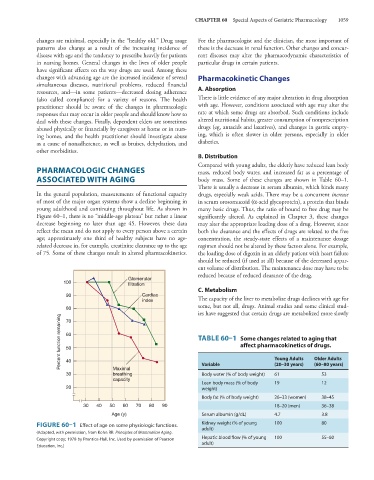Page 1073 - Basic _ Clinical Pharmacology ( PDFDrive )
P. 1073
CHAPTER 60 Special Aspects of Geriatric Pharmacology 1059
changes are minimal, especially in the “healthy old.” Drug usage For the pharmacologist and the clinician, the most important of
patterns also change as a result of the increasing incidence of these is the decrease in renal function. Other changes and concur-
disease with age and the tendency to prescribe heavily for patients rent diseases may alter the pharmacodynamic characteristics of
in nursing homes. General changes in the lives of older people particular drugs in certain patients.
have significant effects on the way drugs are used. Among these
changes with advancing age are the increased incidence of several Pharmacokinetic Changes
simultaneous diseases, nutritional problems, reduced financial
resources, and—in some patients—decreased dosing adherence A. Absorption
(also called compliance) for a variety of reasons. The health There is little evidence of any major alteration in drug absorption
practitioner should be aware of the changes in pharmacologic with age. However, conditions associated with age may alter the
responses that may occur in older people and should know how to rate at which some drugs are absorbed. Such conditions include
deal with these changes. Finally, dependent elders are sometimes altered nutritional habits, greater consumption of nonprescription
abused physically or financially by caregivers at home or in nurs- drugs (eg, antacids and laxatives), and changes in gastric empty-
ing homes, and the health practitioner should investigate abuse ing, which is often slower in older persons, especially in older
as a cause of nonadherence, as well as bruises, dehydration, and diabetics.
other morbidities.
B. Distribution
Compared with young adults, the elderly have reduced lean body
PHARMACOLOGIC CHANGES mass, reduced body water, and increased fat as a percentage of
ASSOCIATED WITH AGING body mass. Some of these changes are shown in Table 60–1.
There is usually a decrease in serum albumin, which binds many
In the general population, measurements of functional capacity drugs, especially weak acids. There may be a concurrent increase
of most of the major organ systems show a decline beginning in in serum orosomucoid (α-acid glycoprotein), a protein that binds
young adulthood and continuing throughout life. As shown in many basic drugs. Thus, the ratio of bound to free drug may be
Figure 60–1, there is no “middle-age plateau” but rather a linear significantly altered. As explained in Chapter 3, these changes
decrease beginning no later than age 45. However, these data may alter the appropriate loading dose of a drug. However, since
reflect the mean and do not apply to every person above a certain both the clearance and the effects of drugs are related to the free
age; approximately one third of healthy subjects have no age- concentration, the steady-state effects of a maintenance dosage
related decrease in, for example, creatinine clearance up to the age regimen should not be altered by these factors alone. For example,
of 75. Some of these changes result in altered pharmacokinetics. the loading dose of digoxin in an elderly patient with heart failure
should be reduced (if used at all) because of the decreased appar-
ent volume of distribution. The maintenance dose may have to be
reduced because of reduced clearance of the drug.
Glomerular
100 filtration
C. Metabolism
90 Cardiac The capacity of the liver to metabolize drugs declines with age for
index
some, but not all, drugs. Animal studies and some clinical stud-
80
ies have suggested that certain drugs are metabolized more slowly
Percent function remaining 60 TABLE 60–1 Some changes related to aging that
70
affect pharmacokinetics of drugs.
50
40
(20–30 years)
(60–80 years)
61
Body water (% of body weight)
breathing
53
30 Maximal Variable Young Adults Older Adults
capacity
Lean body mass (% of body 19 12
20 weight)
Body fat (% of body weight) 26–33 (women) 38–45
30 40 50 60 70 80 90 18–20 (men) 36–38
Age (y) Serum albumin (g/dL) 4.7 3.8
FIGURE 60–1 Effect of age on some physiologic functions. Kidney weight (% of young 100 80
adult)
(Adapted, with permission, from Kohn RR: Principles of Mammalian Aging.
Copyright copy; 1978 by Prentice-Hall, Inc. Used by permission of Pearson Hepatic blood flow (% of young 100 55–60
Education, Inc.) adult)

